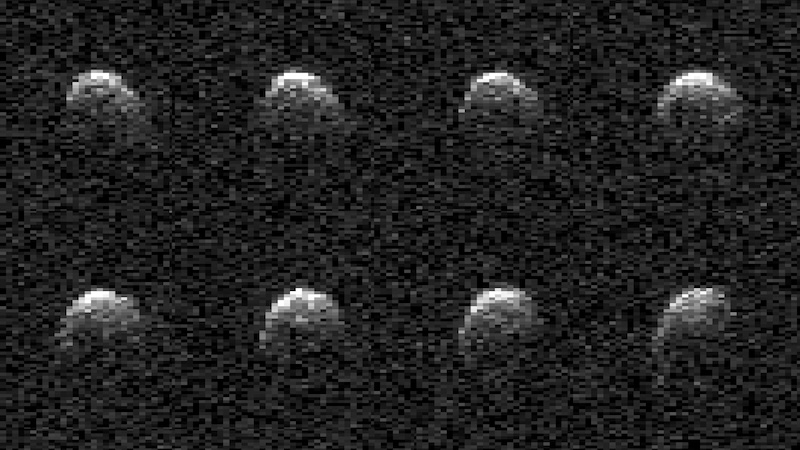
- A large asteroid passed by Earth in February 2024. At its closest point to Earth, it was 1.8 million miles (2.9 million km) away, nearly 8 times the moon’s distance.
- It was notable because, at the 2024 pass, scientists were able to obtain radar images of it, and to learn crucial data about its size, rotation, shape and surface details.
- This asteroid – 2008 OS7 – is designated as a Near-Earth Object (NEO). That means its closest point to the sun is about the distance of Earth’s orbit (less than 1.3 Earth-sun distances) or less. Thus 2008 OS7 and all NEOs carry a risk of a future collision with Earth.
Early last month, a large asteroid designated 2008 OS7 passed safely by Earth. At its closest, it was 1.8 million miles (2.9 million km) away. That’s about 7.5 times the distance between Earth and the moon. So there was no collision danger from this asteroid in 2024, but it was of interest because scientists at NASA’s Jet Propulsion Laboratory in Pasadena, California, were able to track it closely as it passed by. Using the powerful 230-foot (70-meter) Goldstone Solar System Radar antenna located in the desert near Barstow, California, they obtained radar images of the space rock. NASA released the images to the public on February 26, 2024, saying data obtained in the 2024 pass allowed scientists to determine the size, rotation, shape and surface details of 2008 OS7.
What we already knew about asteroid 2008 OS7
2008 OS7 is what astronomers call a Near-Earth Object (NEO). In other words, its closest point to the sun is 1.3 astronomical units (AU, or Earth-sun distances). Such asteroids enter the realm of our solar system where Earth orbits, and so they pose a potential danger to Earth, carrying the risk of a future collision.
Note that 2008 OS7 was not a risk in February 2024. It passed by at a wide distance this time.
Astronomers first discovered 2008 OS7 way back on July 30, 2008; hence, the “2008” in its designation. The NASA-funded Catalina Sky Survey (CSS), at the University of Arizona in Tucson, Arizona, was the first to detect it in 2008. Subsequent observations led by Petr Pravec at the Astronomical Institute of the Czech Academy of Sciences in Ondrejov, Czech Republic, showed that it rotated slowly, about once every 29 1/2 hours. The researchers also studied the asteroid’s light curve in 2008. That is, they studied subtle changes in the brightness of the asteroid over time. Variations in the shape of 2008 OS7 cause the changes in brightness.
By studying how much light was reflected off the surface of this object, the astronomers were able to obtain a rough estimate of its size. They said they believed it was about 650 to 1,640 feet (200 to 500 meters) across.
February 2, 2024, close approach
The 2024 close approach to Earth of 2008 OS7 took place on February 2. The 2024 close approach provided an opportunity to add to the previous observations. This time, the researchers used the Goldstone Solar System Radar antenna in California to take a close look at 2008 OS7. They confirmed the slow rotation period, but also found that the asteroid is smaller than first estimated. The new observations suggest it is only 500 to 650 feet (150 to 200 meters) wide.
The new images and data also revealed more detailed information about 2008 OS7’s surface. They showed that some parts of the asteroid are rounded, while others are more angular.
Scientists want to know 2008 OS7’s orbit (and the orbit of all NEOs) as precisely as possible. The goal is to monitor them for any future potential impacts on Earth. The new radar observations helped to refine our knowledge of the orbit of 2008 OS7. The asteroid orbits the sun every 2.6 years. At its closest to the sun, it comes within the orbit of Venus. And, at its farthest, it goes out past Mars.
The 2024 observations also proved that this object poses no immediate danger to Earth. The scientists learned that 2008 OS7’s approach in February is the closest it will come to Earth for at least another 200 years.

Sometimes, asteroids do hit Earth
On January 21, 2024, a small asteroid did hit Earth’s atmosphere over Germany. On February 5, scientists at the SETI Institute said that analysis of meteoritic fragments showed the asteroid was a rare type called an aubrite.
Meteorites – or space rocks that have struck our atmosphere and survived to reach Earth’s surface – typically have a thin black outer crust, resulting from their fiery passage through Earth’s atmosphere. Aubrites, however, have a mostly translucent and glassy crust.
The January 2024 asteroid was much smaller than 2008 OS7. It was only about 3 feet (1 meter) across. And rather than coming from the outer solar system, the scientists said that it might have originated on the sun’s innermost planet, Mercury.
Bottom line: NASA scientists used the Goldstone Solar System Radar in California to take images of asteroid 2008 OS7 as it passed by Earth on February 2, 2024.











